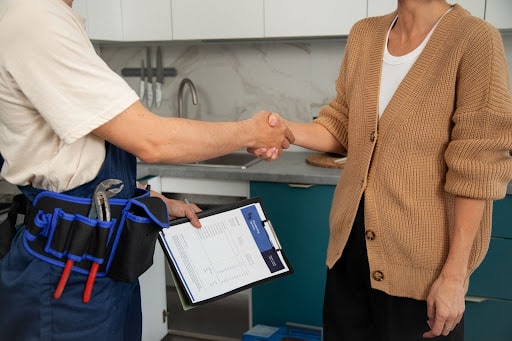Moving into a new house is exciting, but it can quickly turn stressful if plumbing issues arise unexpectedly. You might be unpacking boxes one minute and scrambling to stop a leaking pipe the next. Before you fully settle in, you’ll want to check a few key areas of your home’s plumbing to avoid bigger problems down the road.
If you’re a first-time homeowner or moving to your forever home, this new home plumbing checklist will help you stay ahead of trouble. It’s not just about fixing what’s broken; it’s about making sure your systems are running safely and efficiently.
What plumbing checks should I do before moving in?
Check main systems for leaks, pressure, and shut-off access.
Before moving in, inspect the main plumbing components. Catching early signs of trouble can prevent future headaches.
What to inspect:
- Water meter and shut-off valve: Know where they are and make sure they work.
- Water pressure: Use a gauge to check that pressure falls between 45–60 psi.
- Visible leaks: Look under sinks, around the water heater, and behind toilets.
- Signs of water damage: Discoloration or soft spots on walls and ceilings.
How do I test the water pressure in my new home?
Use a basic pressure gauge on an outdoor spigot or laundry hookup.
Too much or too little pressure can damage pipes or reduce flow.
How to test:
- Attach a water pressure gauge to an outdoor faucet.
- Turn the tap fully open.
- Read the gauge: aim for 45–60 psi.
If it’s over 80 psi or under 40, it’s time to call a local plumber in Texas to adjust it properly.
Why is a home plumbing inspection important?
It finds hidden issues before they become emergencies.
Even new-looking homes can have old or faulty pipes. A home plumbing inspection uncovers problems that aren’t visible during a standard walk-through.
What inspections include:
- Water heater performance
- Drainage and venting check
- Sewer line camera scope (if needed)
- Pipe material and condition
Schedule a full inspection with OnPoint’s residential team to protect your investment.
Should I replace old fixtures right away?
Yes, if they’re leaking, corroded, or have waste water.
Old faucets, toilets, or showerheads may look fine, but could be inefficient or prone to leaks. Replacing them improves both performance and water savings.
Fixtures worth updating:
- Toilets: Choose water-saving models (1.28 gallons/flush).
- Faucets: Look for corrosion or slow drips.
- Showerheads: Swap older ones for high-efficiency units.
A professional from OnPoint Plumber can help upgrade your fixtures safely.
How do I check for hidden plumbing issues in walls or ceilings?
Look for soft spots, musty smells, or bubbling paint.
Sometimes, plumbing problems stay hidden until it’s too late. Learn to spot the signs early.
Watch out for:
- Ceiling bubbles or stains
- Wall discoloration
- Musty odor or mildew
- Peeling paint
Use a moisture meter to confirm hidden leaks, or get a plumbing services expert in Texas to check it thoroughly.
What plumbing tasks should I add to my maintenance plan?
Routine checks every 3–6 months keep things running smoothly.
Creating a plumbing maintenance guide helps you stay ahead of repairs and extend your system’s lifespan.
Suggested schedule:
Task | Frequency | Who Should Do It |
Check for leaks | Every 3 months | Homeowner |
Flush water heater | Once a year | Plumber |
Inspect pipes and joints | Every 6 months | Homeowner or plumber |
Clean drains | Monthly | Homeowner |
Test the water pressure | Twice a year | Homeowner |
What if I have a septic system or sump pump?
Test them before move-in and plan regular service.
Homes outside the city may rely on septic tanks or sump pumps. These systems require special attention.
Key tips:
- Septic tanks: Pump every 3–5 years, depending on usage
- Sump pumps: Test by pouring water into the pit—check the float switch
- Check for backups: Inspect drain fields for pooling or odor
If unsure, let a plumbing professional evaluate these during your home plumbing inspection.
How much can plumbing issues cost you later?
You could face thousands in water damage or pipe repairs.
Ignoring plumbing problems can lead to burst pipes, flooded basements, and mold issues, especially in Texas, where climate change can strain older systems.
Potential repair costs:
Issue | Estimated Cost |
Burst pipe repair | $500–$1,500 |
Water heater replacement | $1,200–$3,000 |
Slab leak repair | $2,000–$6,000 |
Mold remediation | $2,500+ |
Preventive maintenance is always cheaper than emergency repairs.
How Plumbing Inspections Increase Home Value
- Start with a Home Plumbing Walkthrough A full inspection of all plumbing systems inside and outside the home.
- Identify Existing or Potential Issues Detect leaks, corrosion, low pressure, outdated fixtures, or hidden damage.
- Prevent Costly Water Damage Fixing small problems early avoids major repairs and insurance claims.
- Extend the Lifespan of Your Plumbing System Well-maintained pipes, fixtures, and appliances last longer and work better.
- Boost Overall Home Value A healthy plumbing system increases buyer confidence and resale appeal.
When should I call a professional plumber?
As soon as you notice leaks, low pressure, or slow drains.
Some problems are quick DIY fixes, but others need a licensed Texas plumber to prevent worse damage.
Call immediately if:
- You smell gas near the water heater
- Your home has outdated galvanized pipes
- You see signs of water damage without a known source
- The water heater doesn’t produce hot water consistently
Reach out to OnPoint Plumbing Services for fast, friendly help.
Ready to settle in? Don’t skip your plumbing checklist.
Moving day is busy, but plumbing shouldn’t be overlooked. Taking the time to check your systems now can save you from water damage, surprise leaks, and costly repairs later. As you unpack and settle into your new space, remember: safe plumbing = peace of mind.
Whether it’s inspecting the water heater, replacing old fixtures, or scheduling a full home inspection, your first call should be to a trusted local plumber in Texas. At OnPoint Plumber, we help homeowners like you feel confident from day one.
Contact us today to schedule your home plumbing inspection or ask questions about your specific needs.
We’re here to make your move smoother, your pipes safer, and your home more comfortable.
Frequently Asked Questions
What’s the first plumbing task after moving into a new home?
Locate and test your main shut-off valve and inspect visible pipes for leaks. It sets the stage for a safer, well-maintained system.
How often should I do a home plumbing inspection?
Plan for once a year. A full home plumbing inspection helps catch problems early and keeps your system running smoothly.
Is it worth replacing old toilets and faucets?
Yes, new models save water and lower your bills. It’s a simple fix that boosts efficiency and reliability.
Can I handle plumbing checks myself?
Some basic checks, as looking for leaks or testing pressure, are DIY-friendly. But always call a local plumber in Texas for anything serious.
What’s included in professional plumbing services in Texas?
Inspections, repairs, fixture replacements, and emergency help. OnPoint Plumber covers everything from kitchens to full system diagnostics.

